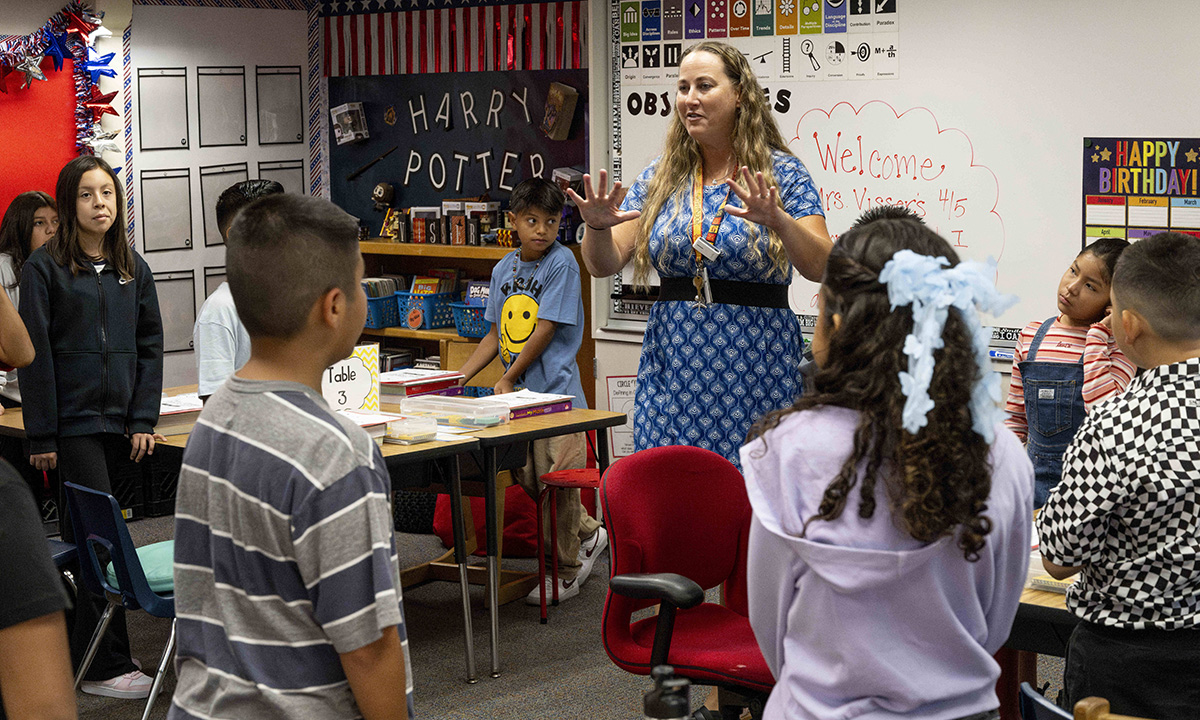Teach For America Should Embrace Apprenticeship Model Amid AmeriCorps Cuts
Donaldson: An apprenticeship model would provide the funding and the training needed to bring more teachers into the classroom.

Get stories like this delivered straight to your inbox. Sign up for The 74 Newsletter
Teach For America (TFA) has long worked to bring talented individuals into classrooms across the country, particularly in schools facing persistent staffing shortages. But with recent cuts to AmeriCorps funding — a key funding source which supports TFA corps members —TFA must consider new, sustainable approaches to preparing future teachers.
As the saying goes: never let a crisis go to waste. These cuts present a chance for TFA not only to address its funding structure, but also to rethink how it prepares the young people it recruits. Now is the right time to evolve the model in ways that improve both financial sustainability and teacher readiness.
I say this not as an outsider, but as someone who went through the program. I’m a Teach for America alum, and like many of my peers, I entered the classroom deeply committed — but not fully prepared. I cared about my students, I believed in the mission, but I didn’t have enough time, training, or support to meet the demands of the job on day one. That experience has stayed with me and shaped my thinking about what future corps members need.
One powerful way forward for TFA? Become a registered apprenticeship program.
Registered apprenticeships are gaining traction as a practical solution to the national teacher shortage. These programs allow individuals to earn while they learn, combining paid, on-the-job experience with structured training and support. For TFA, integrating into this model could strengthen the quality of corps member preparation while opening up access to federal and state workforce funding.
Rather than placing corps members into classrooms after only a few weeks of training, TFA could design a first-year experience as a paraprofessional apprenticeship. During this year, participants would work under the guidance of a certified teacher while gaining real-time experience and completing relevant coursework. The result: corps members who are more confident, capable, and better prepared to take on full teaching responsibilities in their second year and beyond.
This would be a meaningful shift from the current model, which places new corps members in lead teaching roles almost immediately. But the whole point of an apprenticeship is that someone learns to do the job — they’re not expected to fully do the job on day one. That’s what separates this model from TFA and why it has become so attractive to states seeking to address both quality and pipeline issues.
TFA could also offer an early admittance track. College seniors accepted into the corps could spend their final year of college working part-time as paraprofessionals in local schools. This would give them an earlier entry point into the profession while helping districts meet staffing needs and reducing the ramp-up time before full-time teaching begins.
TFA has already laid the groundwork for the registered apprenticeship approach. In Memphis and Nashville, the organization operates as its own educator preparation provider (EPP), training corps members directly in alignment with its expectations and priorities. Expanding this model to additional states — particularly those supportive of registered apprenticeships — would give TFA greater control over training while accessing workforce dollars to support instruction, coaching, and operational costs.
In states like Arkansas, TFA could consider a different kind of partnership. The Arkansas Department of Education has created its own EPP and is launching a K-12 special education teacher registered apprenticeship program. TFA could partner with such states to enroll corps members in high-quality, state-run programs at no cost. These arrangements would allow TFA to focus on recruitment, placement, and ongoing support while relying on the state’s infrastructure for licensure and training.
These strategies offer clear financial benefits. Apprenticeship funding can cover tuition, licensure costs, and other expenses currently borne by TFA or corps members. In a time of tightening budgets and rising preparation costs, these savings could help TFA maintain or expand its footprint without compromising on quality.
It would also allow the organization to better support the people it recruits, many of whom want to become effective teachers but find themselves underprepared and overwhelmed. By investing in a more gradual and structured on-ramp into the profession, TFA can reduce burnout, improve retention, and ultimately deliver better results for students.
TFA has always been known for innovation and responsiveness to the needs of schools. By embracing the registered apprenticeship model, it can meet this moment with a new strategy: one that addresses the funding crisis head-on while finally tackling long-standing concerns about corps member readiness.
This is not about walking away from the core of what made TFA successful. It’s about strengthening it. Apprenticeship offers a chance to double down on the mission by building a better bridge into teaching, honoring the complexity of the role and giving new educators the time, training, and support they deserve.
Get stories like these delivered straight to your inbox. Sign up for The 74 Newsletter

;)
